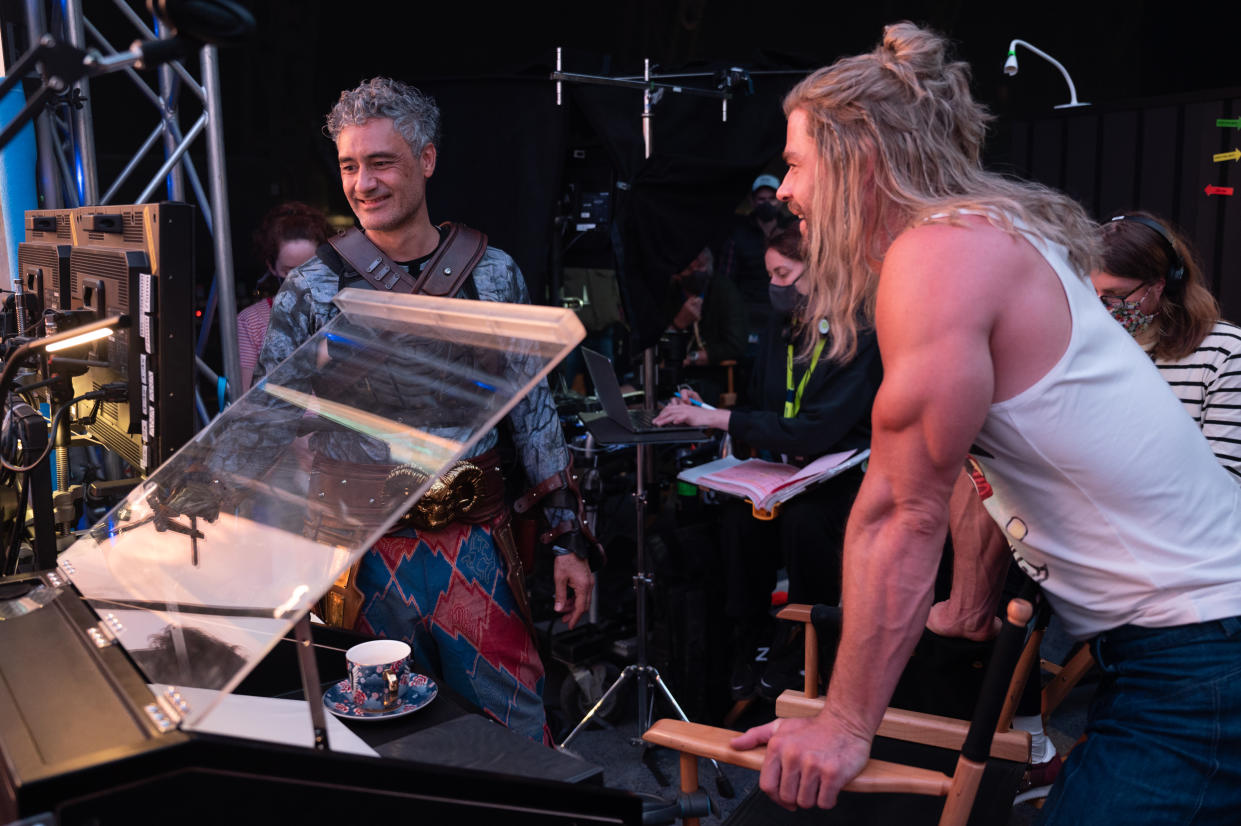‘Thor: Love and Thunder’ Takes a Hammer to Marvel’s Green Screen Problems

- Oops!Something went wrong.Please try again later.
With “Thor: Love and Thunder,” Marvel entered the volume for the first time, courtesy of ILM’s game-changing StageCraft platform. Developed for the Emmy-winning “The Mandalorian” and used most recently for “Obi-Wan Kenobi,” “The Book of Boba Fett,” and the noirish Gotham cityscapes of “The Batman,” StageCraft gives Marvel a valuable virtual production tool. The industry leader in VFX-heavy, franchise moviemaking now has experience in shooting actors against immense LED panels displaying virtual sets in real time, reducing reliance on the more traditional but less effective green screen process in favor of a more effective, efficient, and faster workflow.
It’s not surprising that Taika Waititi embraced StageCraft for “Love and Thunder,” given how much the director took to the system when helming the first season finale of “The Mandalorian” and the pilot of HBO Max’s “Our Flag Means Death.” In fact, that’s why ILM built a large-scale custom volume at Fox Studios Australia, where “Love and Thunder” was shot by “Mandalorian” cinematographer Barry Idoine. And judging from the results, “Love and Thunder” not only benefited from StageCraft but also allowed the technique to flourish, thanks to a funky look that encompassed both colorful and monochromatic space environments.
More from IndieWire
'Next Goal Wins' Trailer: Taika Waititi's Soccer Comedy Is Finally, Finally Here
Kathleen Kennedy Offers Updates on Rian Johnson and Taika Waititi 'Star Wars' Movies
Waititi said this provided quite a stage for Thor (Chris Hemsworth) and friends — Valkyrie (Tessa Thompson), Korg (Waititi), and Jane Foster/Mighty Thor (Natalie Portman) — to battle Gorr the God Butcher (Christian Bale). “The best thing about it is that the actors can see the environment and they’re lit by it,” he told IndieWire. “You don’t have to put a tennis ball on the ceiling and have them react to it. And for them to say, ‘What am I looking at?’ And you say, ‘No idea, we’ll figure it out in six months. It could be a dragon, it could be a cave troll.’ The best thing is that there’s clearly a world around them they can see and a lot of what you’re getting is in-camera.
“It definitely has its limitations,” Waititi said. “It’s in a room so you can’t get the camera super far back or too high. It doesn’t help with coverage. But it’s a nice way of working. You can control where the sun is in the sky and shoot at magic hour at the same time of day as something else and control that weather. It’s amazing.”
The pivot toward StageCraft provides Marvel with an in-camera alternative that allows for more interactive and dynamic lighting and reflections — as witnessed in previous StageCraft projects — and perspective-accurate camera tracking to create the illusion of shooting on location. Beginning with Season 2 of “The Mandalorian,” ILM increased the resolution of StageCraft with its in-house renderer, Helios, in addition to extending the use of physical sets near the volume. More work can be front-loaded, relegating post-production to more creative refinement.
“Also the work can be more spontaneous and, if you are good at it, take advantage of the happy accidents that take place when everything is movable and in real-time,” one VFX industry insider told IndieWire. “The impact is fairly huge and will help cement this technique as a huge timesaver.”
That’s not to suggest that StageCraft will do away with the need for green screen work on Marvel movies anytime soon. Despite ILM’s global expansion, which currently consists of three permanent volumes in LA, one in Vancouver, and one at Pinewood Studios in London — where another “Mandalorian” directing alum, Peyton Reed, is using StageCraft on “Ant-Man and the Wasp: Quantumania” — there aren’t enough volumes to keep up with Marvel’s demanding film slate and busy production schedules.
“It can’t do everything — you still need several techniques — but the aggregate can produce a quicker, high-quality film than currently done,” the insider said.
In the video below, watch cinematographer Greig Fraser break down the use and benefit of StageCraft for “The Mandalorian” Season 1.
Additional reporting by Eric Kohn.
Best of IndieWire
Sign up for Indiewire's Newsletter. For the latest news, follow us on Facebook, Twitter, and Instagram.


